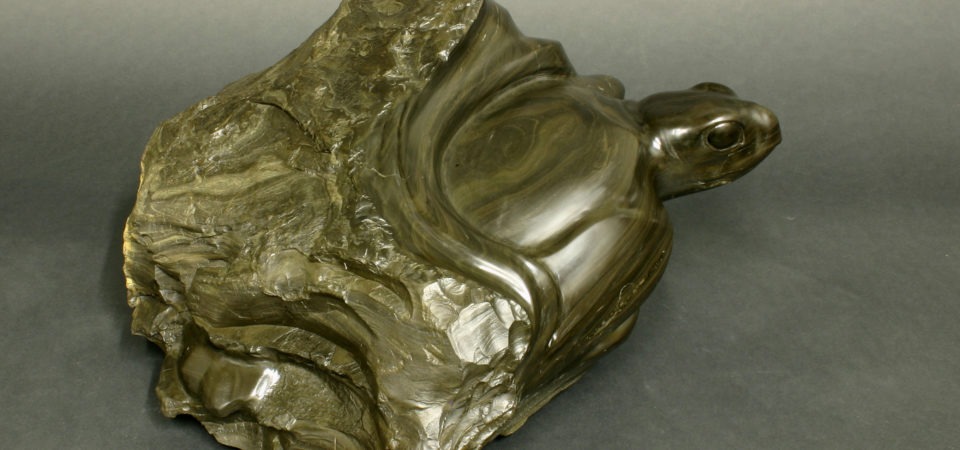Gulf Stream 11 x 24 x 24″, Oil Shale.
When asked where I get my inspiration, the answer is always nature.
The feeling I have when seeing a bird in flight or a fox with her kit is intensely fulfilling. Conveying that feeling to others is the challenge. I like to say my subject matter is design, flow, and balance using nature as my guide. I try to get my message across in a subtle, and sometimes a not so subtle, in your face kind of way. As a signature member of the Society of Animal Artists, I am part of a group of artists devoted to promoting excellence in the artistic portrayal of the creatures sharing our planet and to the education of the public.
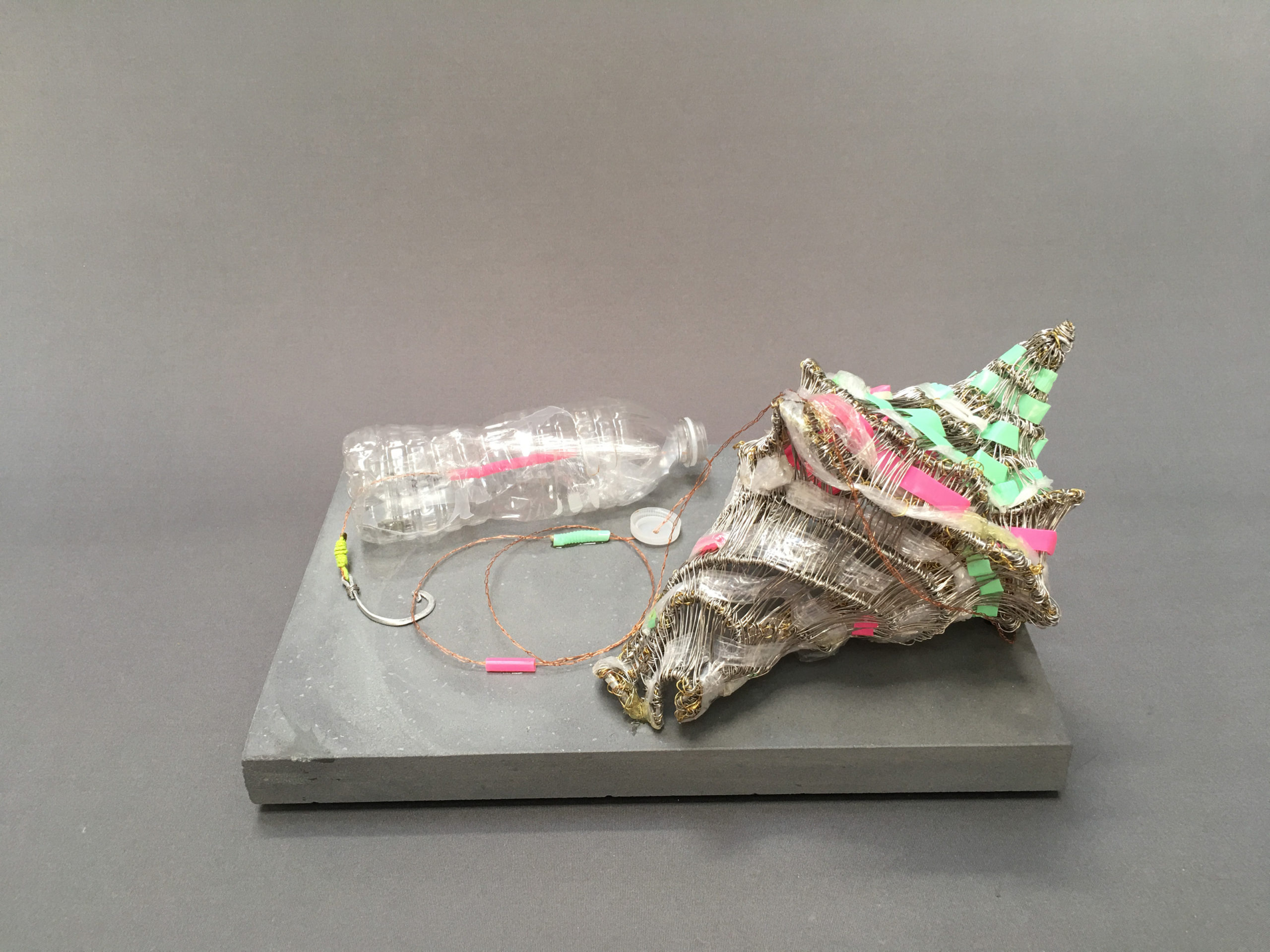
Food Chain
8 x 14 x 9.5″
wire, plastic
When artists share their work, they, of course, are wearing their hearts on their sleeves. Putting forth an emotion, making commentary, and in some ways recording history, often in metaphor. The Society of Animal Artists’ “Art That Matters to the Planet Exhibition and Tour” is a wonderful example of artists inviting you to view the world through their eyes. The tour, which was organized by the indefatigable Exhibit Curator, Dr. David J. Wagner, started in August at the beautiful Roger Tory Peterson Institute. Their mission statement is in line with my view in that we use art as the lens through which to inform, inspire and illuminate the natural world. I am privileged to have my piece “Food Chain” included in this traveling art show. The next stop will be the enchanting Hiram Blauvelt Art Museum in Oradel, NJ, from November 20, 2021, through January 16, 2022. This museum sits high on a hill with a woodland setting. I am honored to have two of my sculptures in The Blauvelt’s permanent collection, a bronze, over life-size pair of otters and a marble carving of a whale tail. The last stop of the tour will be the Sternberg Museum of Natural History at the Ft. Hays State University in Kansas from February 5 to May 5, 2022. You have to love meandering through a museum and seeing thousands of years of history and artifacts and ending up in an art show to bring you back to the present.
As an artist, I seek to inspire but also raise awareness of social and ecological challenges facing the world. Social media outlets have brought to the forefront the perils of the pollution affecting the ocean and its inhabitants. Often I have to make a piece just for me, not with an eye towards selling it, and “Food Chain” is such a piece. It addresses the fact that man has forever impacted our oceans as heavy metals and plastics are found in all the creatures in the sea. This pollution inevitably works its way up to the top ocean predators and onto our dinner plates. “Food Chain” shows a conch shell infused by metal and plastics, encircled by even more plastic and the fish hook, which will bring a harvest from the sea to our plate.
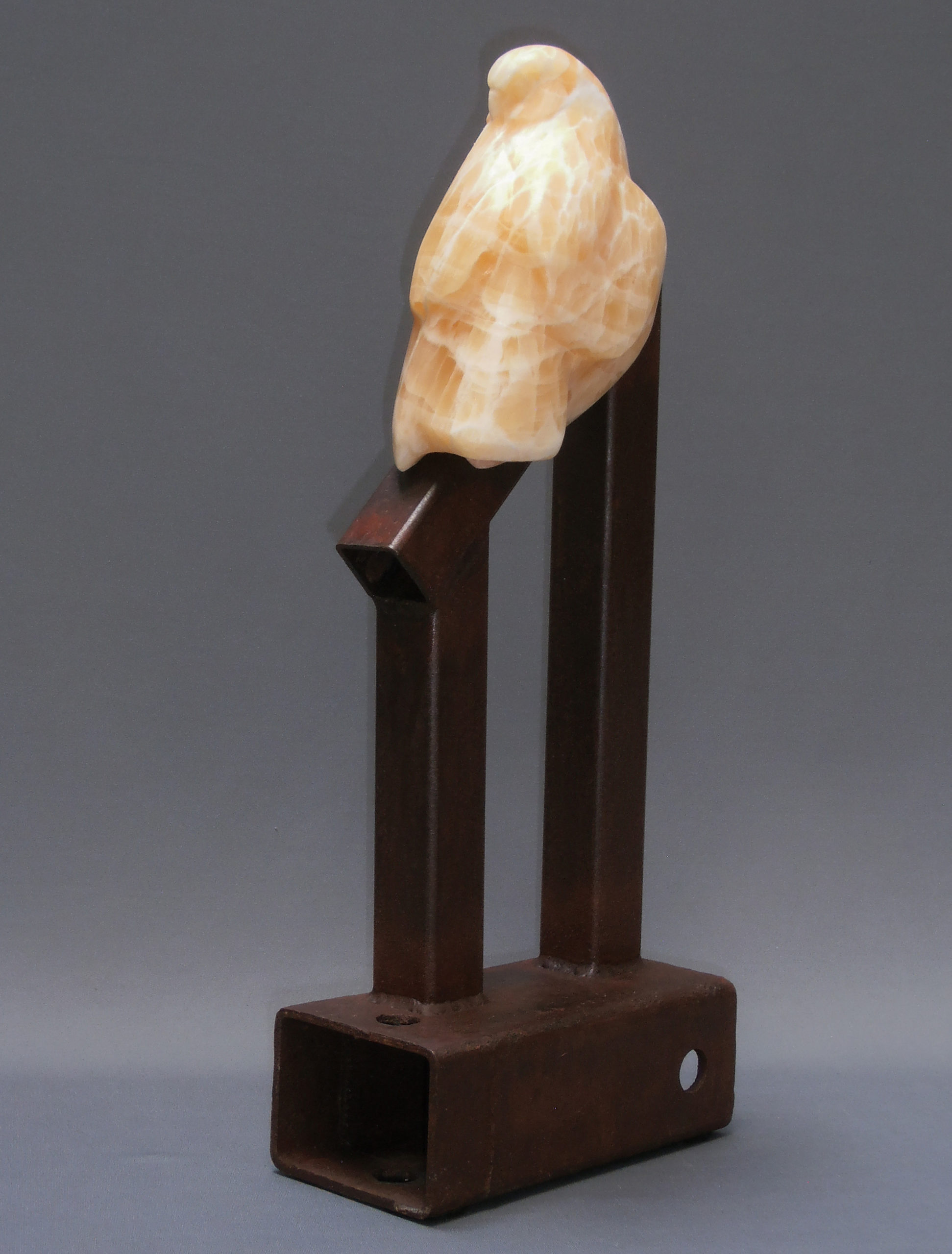
Urban Renewal
20 x 8.25 x 4″
My husband Dave and I, along with our hound Honey, live in the foothills of the Rockies and are fortunate to have all types of animals close to us. We have elk, deer, bear, cougar, fox, bobcat, and coyote regularly visiting our home. A short hike brings me to a bison herd managed by the Denver Parks system in a nearby valley, and it is always a treat to visit them. Seeing a subject in its natural habitat is invaluable for reference for an artist as just the tilt of a head can make or break a piece. The landscape will also influence the design and flow of the piece and might spark the story I want to tell.
With the reintroduction of falcons into the cities to control the pigeon population and seeing hawks and owls in nesting boxes on skyscrapers with web-cams, we are noticing more birds of prey in the urban interface area. This inspired the sculptures “Urban Renewal” and “Balancing Act”. As a docent for 16 years with Raptor Education Foundation and for five years with Nature’s Educators, the education and hands-on reference available to me was priceless. I worked in the mews, cleaning, weighing, feeding, and training the non-releasable animals and birds we presented as ambassadors in the programs. Both groups are 501C3 educational outreach organizations and depend on volunteers and donations to share their messages. These programs are offered to anyone interested in learning about the diversity of animals, birds, and insects needed to preserve the world, with the added benefit of live ambassadors in attendance. There is nothing to compare to having a raptor on your glove or a snake wrapped around your arm.
With all these experiences in mind, it was easy to imagine a kestrel visiting an old industrial site to set up a new hunting ground. This became “Urban Renewal”. This one of a kind, calcite on steel sculpture shows a kestrel bringing beauty to an otherwise derelict landscape of rusted steel. Reintroducing a predator to an area overrun by prey, be it small mammals or explosive populations of birds and insects, can bring a balance back and create a healthier environment.
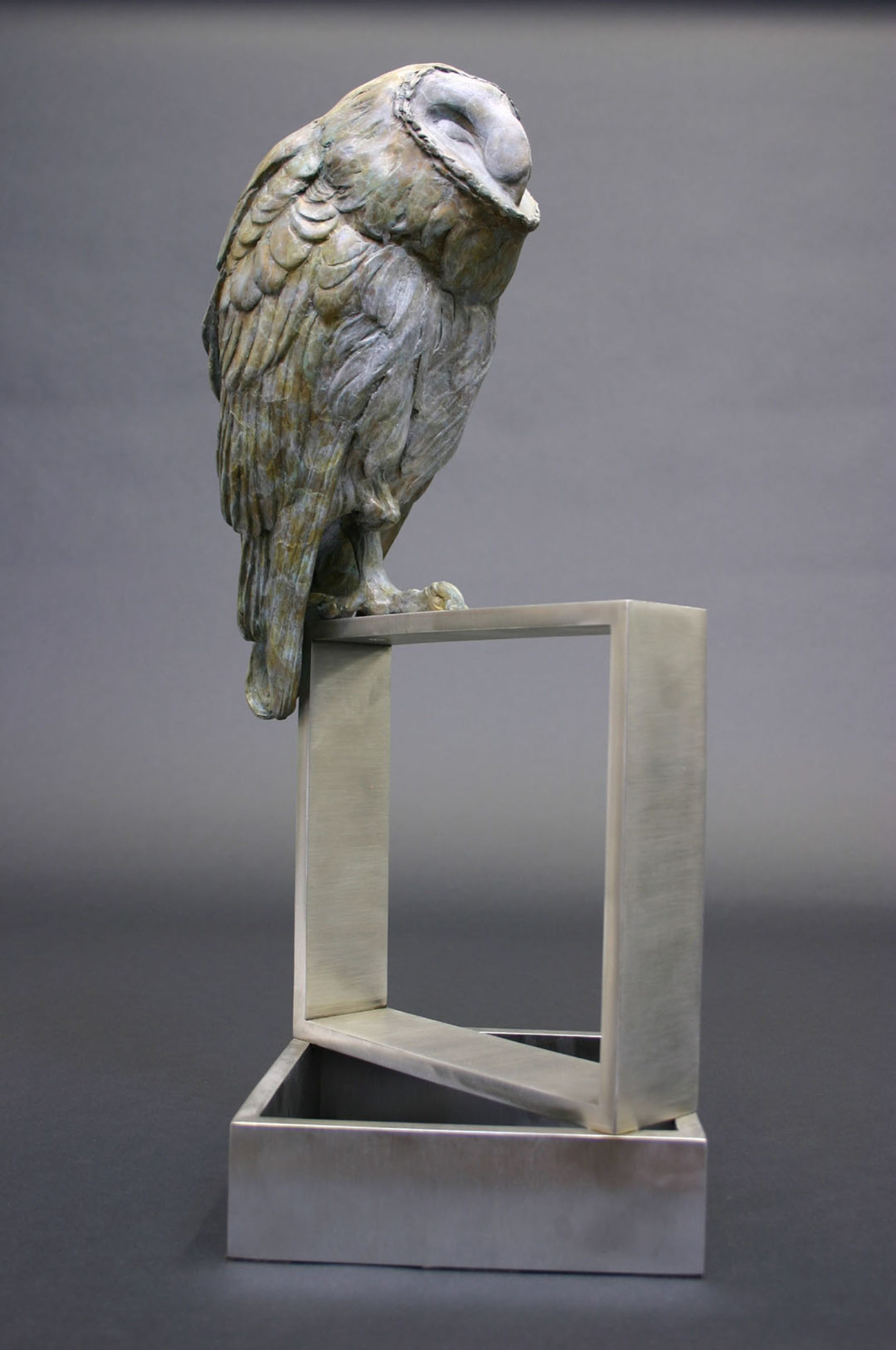
Balancing Act
24 x 8 x 11″
Bronze on Stainless
As we encroach on wilderness areas, it seems a fine balancing act to be in such close proximity to humans competing for space and food. My sculpture “Balancing Act” tells the story of a barn owl in his new modern high rise in the city, peacefully cohabitating in a concrete wilderness. It is in our best interest to coexist with these predators who keep our rodent populations in check. One researcher counted 32 mice brought back to a nest in 30 minutes. A pair of nesting barn owls and their chicks can eat approximately 1400 rodents in a season and twice that if they double clutch. These animals are so beneficial to us working behind the scenes. Keeping a balance of predator and prey protects us from disease and food shortages. Healthy biodiversity depends on all critters to keep a balanced ecosystem. Everything is connected.
When the Deepwater Horizon oil spill occurred in 2010, many conservation groups sprang into action to help the marine life affected. Famously, many turtle egg nests and hatchlings were relocated from the Texas gulf coast to the Atlantic coast of Florida, which may have saved more than 25,000 hatchlings. We know turtles return to the same beaches from where they hatched. Depending on the species, it can take 11-16 years for Ridleys to reach sexual maturity, so I am curious to find if they will return to Florida or Texas to lay the next generation. The sculpture “Gulf Stream” was created with this in mind. A Kemp’s Ridley turtle appropriately carved from a single piece of oil shale rock that is used in fracking. The contrast of the polished and raw stone emphasizes the perils of the long journey ahead giving tension to what might have been a serene piece had its surface been all polished.

Gulf Stream
11 x 24 x 24″
Oil Shale
As we see whole forests and jungles being clear cut to make room for humans, farming, grazing, and harvesting wood for products for our ever-growing populace, we leave smaller spaces for our creatures to survive. My brother-in-law was my wood supplier for many years. He would gather the red cedar burls for me. They were trash to the loggers who wanted nice straight grain and would end up in their slash and burn piles. “Basics” is made from red cedar burl and wood products symbolizing the empty space left for the owl when clear-cutting for basic wood products like paper, pencils, cardboard, and such. The very basic forms of the ovoid, circle and square add to the story for the artist’s eye. Tree farms have more or less been replacing the cutting of old-growth forests in the U.S. but it behooves us to use more fast-growing and sustainable plantings such as bamboo and hemp to produce more of our consumables such as plastics, clothing, construction material, industrial textiles, paper, and even food.
My work is often inspired by a walk in the park or a hike in the forest.

Basics
13 x 7.5 x 6.5″
Red Cedar Burl/wood products
I am so thankful that President Teddy Roosevelt, with some prodding from the environmentalist John Muir, had the foresight to set aside wilderness areas for the beginnings of the national forest and parks systems, which spread to state and local parks and green spaces that we can all enjoy today. If you have the chance, I hope you will make the time to visit one of the beautiful venues hosting the “Art that Matters to the Planet Exhibition and Tour” to see what inspires some of the artists of the Society of Animal Artists and hopefully become inspired yourself.
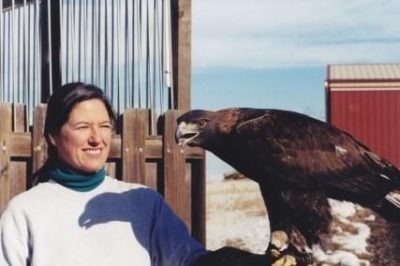 Pati Stajcar has been lucky to call Colorado home for over 40 years. Working in wood, bronze and stone, she uses nature as her guide.
Pati Stajcar has been lucky to call Colorado home for over 40 years. Working in wood, bronze and stone, she uses nature as her guide.
She is an elected member of Academic Artists Assoc., Allied Artists of America, National Sculpture Society, and Society of Animal Artists. She has volunteered as a docent with Raptor Education Foundation, Natures Educators, and as a firefighter with Foothills Fire and Rescue.
Permanent, public placements include; Greeley, Colorado Water Works; Jupiter, Florida City Hall; Lenexa, Kansas Police Station; Cypress Gardens, FL; Orlando, FL Convention Center; Hurst, Texas City Hall; The Wildlife Museum, Parker CO; the Hiram Blauvelt Art Museum in Oradel, NJ; Brookgreen Gardens in Murrells Inlet, SC.
Please visit www.stajcar.com
The Society of Animal Artists Tour, directed by David J. Wagner, Ph.D., will include the following venues:
The Hiram Blauvelt Art Museum
November 20, 2021 – January 16, 2022,
Oradell, NJ
The Sternberg Museum of Natural History
Fort Hays State University
February 5 – May 5, 2022
Hays, KS
The MAHB Blog is a venture of the Millennium Alliance for Humanity and the Biosphere. Questions should be directed to joan@mahbonline.org

